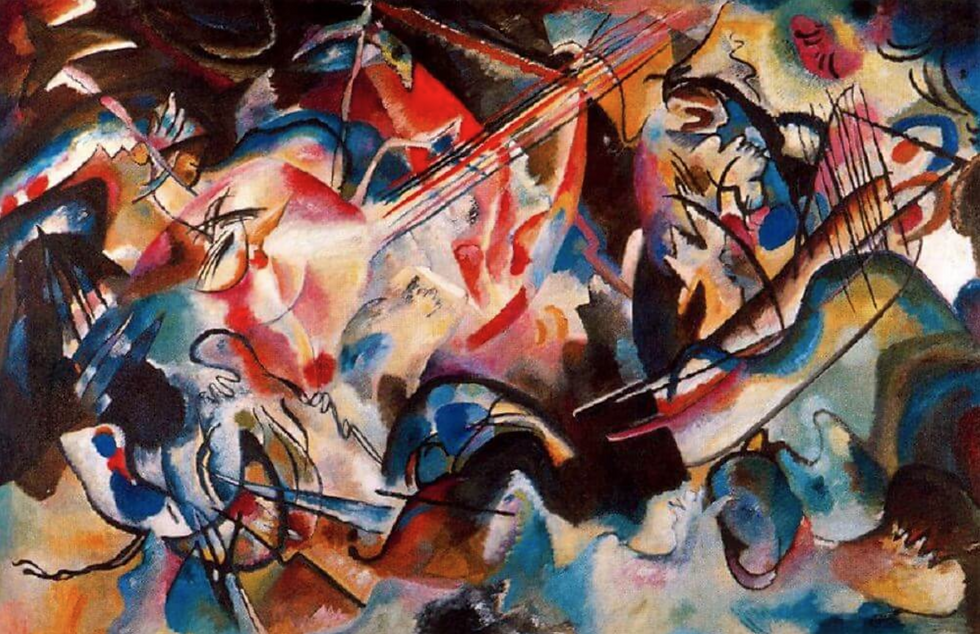Kandinsky's Synesthesia: Subjective Objectivity
- Eugene Lau
- May 4
- 4 min read
While the five senses are biologically distinct and synergize to form, enhance and influence human perception, some are gifted with the ability to experience them as fluid and inherently interchangeable components. This cross-sensory perception is known as synesthesia: a neurological condition where the stimulation of one sensory pathway (e.g. hearing) involuntarily triggers another (e.g. vision). Seeing the innate translation between the senses that imbue the process with objectivity, synesthetes like Wassily Kandinsky sought to systemize his synesthetic perception into a universal, visual language. However, the distinct, non–identical nature of this mechanism personal to each individual synesthete raises a question: Does this disjunctively unified phenomenological experience create a paradox between objectivity and subjectivity?


KANDINSKY’S UNIVERSAL LANGUAGE
Wassily Kandinsky is a Russian artist known for his pioneering abstract modernism in the 20th century. Diagnosed with synesthesia which gifted him the ability of multi-sensory perception, he was able to translate music to paintings. Deeply spiritual in his outlook, Kandinsky believed that colour possessed the power to evoke emotions and transcend the physical world. He was also influenced by the concept of Gesamtkunstwerk, introduced by German composer Richard Wagner, which emphasised the integration of various artistic disciplines and media into a cohesive whole, or a ‘total work of art.’ Kandinsky's artistic vision was also shaped by his involvement with the Blue Rider Group and the German Bauhaus movement. The Blue Rider Group was an artists' association that sought to create a synthesis of different art forms, while the Bauhaus movement aimed to dismantle preconceived hierarchies in the arts and unify the gap between art, craft, and design. By distilling essential forms, Kandinsky believed that merely depicting fundamental geometry and colour was the most effective universal language. In Bauhaus, he approached teaching by deconstructing basic elements–point, line and plane–and examining their relationships.

Investigating geometric and biomorphic forms, Kandinsky visualises his catharsis with synesthetic translation in ‘Composition VI’, depicting seemingly non-representational formal elements. He painted the piece as his main entry for Erster Deutscher Herbstsalon (First German Autumn Salon) held in Berlin. Making studies and preparations for the painting for eight months, he wanted to depict a flood, a baptism and the theme of destruction and rebirth. After his assistant suggested to him to free himself from initial representational outlines and think about the German word 'Überflut' (flood) and the acoustic sensations evoked, Kandinsky finished the painting within three days after the suggestion, reiterating the word for the entirety of the three days.
Despite the chaotic flux of jarring forms and colour, Kandinsky imbues and justifies meaning with the synesthetic process of creating this work. He amalgamates soft and curvilinear lines evoking organic forms and a sense of flow, along with sharp and angular lines connoting tension and contrast. In the upper section of the piece, he synesthetically uses long, solemn lines to convey largo, a musical term denoting “slow and broad”. Lines are connected with those above them, which are in conflict with the crossed direction of the thick and decisive lines. He further incorporates the notion of a fugue, another musical term denoting a composition in which one or two themes are repeated. Placing a fugue of pink spots across the picture to soften the dramatic vibration of lines, he gives the sense of agitation calmness. A solemn and calm character is also highlighted by blue spots, which, against the disturbance of lines, imbues an inner warmth. In addition, Kandinsky synesthetically associates green and yellow as a way to bring life to the soul and provide it with missing activity. (Yellow denotes middle C on a brass trumpet) Another example of his innate, involuntary translation is how, to him, deep brown forms synesthetically contribute a dull and very far-sounding note, reminding one of hopelessness. It now becomes clearer how Kandinsky employs colour, line and plane as his synesthetic visual language, imbuing the phenomenological experience of catharsis with an inner orchestration of sounds and a spiritual essence.
IS HIS UNIVERSAL LANGUAGE TRULY UNIVERSAL?

Synesthesia is a neurological condition where sensory translations are involuntarily, innate, and arguably objective to synesthetes. Kandinsky makes use of this objectivity to form his ideological argument that his works display a universal, objective interpretation of the sounds in his head–the cathartic deluge he experienced at that particular span of time. To use synesthetic translation to visualise thought as acoustic sounds, given Kandinsky’s synesthetic ability, is the most straightforward and logical approach. However, what is objective to him may not be objective to others.
Synesthetes possess distinct cross-sensory perceptions, and a sensory translation cannot be the same for all. Kandinsky’s depiction of yellow for middle C on a brass trumpet, for example, may be experienced differently by another synesthete. It is true that Kandinsky, by nature, objectively represents himself, but this objectivity is intrinsic to him only, or perhaps to a rare few synesthetes who share similar perceptions. As a whole, Kandinsky’s synesthetic view of things is methodically and accurately presented to him, which may be completely different to other synesthetes and non-synesthetes, straying far away from anything close to ‘universal’. If something as magical and natural fails to offer a representational or ‘accurate’ view of the senses, can we truly ever universally agree on a sound that might look like a colour? Unfortunately, it seems that this supernatural experience can only be rational to a particular synesthete to deem the neurological process objective, but is unlikely to the majority of us, who may form cross-sensory connections solely based on subjective preferences.
Other References:
https://artsandculture.google.com/story/vasily-kandin sky-counterpoint-composition-vi-composition-vii-the-state-trety akov-gallery/rQWBjKX9MXThIw?hl=en





Comments